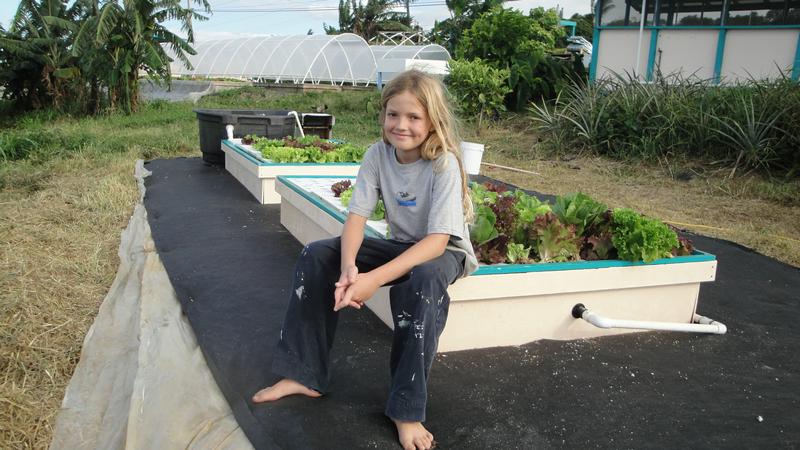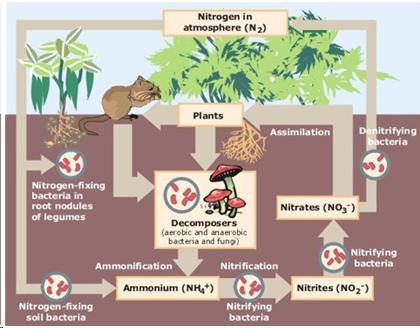General Principles of Hydroponics And Aquaponics:
About aquaponics and hydroponics: many people think aquaponics is just a kind of hydroponics. The two systems are VERY different. First, hydroponics systems are quite susceptible to disease outbreaks, and as a result, hydroponics growers typically need to drain their systems of the expensive nutrients and water they have had to purchase, sterilize them, then refill and add new (expensive!) nutrients to the system.
They often do this two or three times a year, and bear the costs associated with having a system out of production for so long, in addition to the cost of draining, sterilizing, and refilling the systems, then replanting with new crops. So, hydroponics growers are growing in a sterile manner with man-made nutrients in a man-made container (the hydroponics system).
(Below) Happiness doesn’t really need a caption.
Another way that aquaponics and hydroponics are very different is that hydroponics systems are very sensitive to nutrient levels, so the growers have to constantly monitor nutrients and adjust as necessary to achieve optimum balances and pH in the system. Also, the good hydroponics growers have to pay attention to something called “micronutrients”. These are the minerals and nutrients that can give hydroponic produce some flavor (rather than the more commonly available bland and watery-flavored hydroponic produce often found in stores). This phenomenon has given hydroponically grown vegetables somewhat of a bad reputation; and using micronutrients requires more sophisticated and intelligent monitoring and adjustment to reach desired results.
Nutrients In Aquaponics And Hydroponics Systems:
In comparison to sterile, short-lived, and rather fragile hydroponics systems, aquaponics is a dynamic natural ecosystem in a man-made container. This makes it especially easy to work within, since it is constructed with humans in mind! What we have is similar to a healthy pond culture: we have tilapia, mosquito fish, prawns, water fleas, bloodworms, many different kinds of bacteria, algae, various types of sludge, and scores of other macro- and micro-critters as-yet uncounted and uncategorized in our aquaponics systems. They are stable, dynamic, and durable natural ecosystems that never require sterilization, dumping of water, adding of “micronutrients”, or any of the powders and liquids that the hydroponicists must use regularly (and pay for) to get productivity out of their systems. We do need to pump the water and supply air and food to the fish, just as hydroponics growers do who use the same deep bed culture methods. Otherwise, there are very few similarities between aquaponics and hydroponics; aquaponics is easier to maintain, more stable, less expensive to operate, the produce is organically certifiable, AND tastes better than organic grown in soil! And we get fish to eat or sell!
So where do the nutrients in an aquaponics system come from? The fish excrete solid waste and urine into the water as well as excreting ammonia through their gills into the water. The solid fish waste decays into ammonia, so ammonia is the basis for everything that happens next. A bacteria living in the system metabolizes (eats) ammonia and turns it into nitrite, a nitrogen compound. A different bacteria in the system metabolizes the nitrite and turns it into nitrate, a different nitrogen compound. Both ammonia and nitrite are very toxic to the fish, but nitrate is not. All three of these act as fertilizer to the plants in an aquaponic system, which remove them from the water. The plants are harvested, taking the ammonia, nitrite, and nitrate out of the system. The plants clean the water for the fish, and the fish provide fertilizer for the plants. It is a self-balancing recirculating system, which only requires fish food, aeration, and water pumping to keep the cycle going.
As shown in the accompanying diagram, (which shows the nitrogen cycle as it occurs in the ground) these bacteria take ammonia, which is a product of bacterial decomposition of any organic waste (plant material, rotten fruit, dead brush, fish excreta), and turn it into nitrite, then into nitrate, which are then taken up by the plants and turned into plant material, which is taken out of the system by harvesting. So, we would like to express our sincere appreciation to nitrifying bacteria for making it all possible. Thanks, little guys!
Here’s a graphic that demonstrates the nitrogen cycle as it occurs in the ground. What happens in an aquaponics system is quite similar.
General Categories of Aquaponic Systems:
Modern aquaponics has been in development for 25 years. There is an increasingly complete and accessible body of knowledge on the subject; it should be easy to find information and become successful. However, many individuals keep trying unsuccessful things over and over because they don’t bother to do their research. The best approach is to be well-informed about what aquaponics is and is not. Much of “aquaponics” bears a closer look to determine what general category it fits into. Here are some examples:
Experimental systems: Some experiments are done by people with a good working knowledge of current aquaponics technology to investigate a new idea; these experiments are likely to bear fruit. Even if the desired outcome isn’t achieved, the information gained in a well-designed experiment is often as valuable as if it had worked; you’ve learned something to not waste any more time on.
Some experiments are done by people with little or no understanding of aquaponics using incorrect experimental procedure, and not operated for a sufficient length of time to make any accurate conclusions or get any useful information. They still claim their imaginary results are valid! As we say, “Run away, run away!”.
Hobby systems: A system built and operated with no requirement for financial return (or its equivalent in vegetables and fish) is a hobby system. If you want a hobby system, being well-informed about aquaponics will ensure that you have a good hobby system that is fun to own and operate, rather than a bad-smelling backyard disaster!
Demonstration systems show how aquaponics and hydroponics work, and are not necessarily economically productive systems. You see them used in schools for teaching general principles of aquaponics and hydroponics. Most of the aquaponics and hydroponics “kits” on the market fall into this or the hobby system category.
Family system or backyard system: A family system makes sense from a money point of view: it pays its operating costs (consumables, utilities, seeds, and fingerling fish) AND still makes two to three (or more!) times as much produce as you could buy for the same amount of money. If it doesn’t do this, it is a hobby system. It may be an expensive hobby system with a big investment in it, but it is still a hobby system. A good system feeds the people who run it; it is economical, easy to build and operate, is long lasting, and can grow many varieties of vegetables.
A commercial system pays its operating costs (consumables, utilities, labor, overhead, and management), its depreciation on equipment, its debt service or return to investment, and still has a profit. If it doesn’t meet these criteria, it is a hobby system. A commercial system generates a profit year after year, and financially supports the people who run it; this profit also allos system expansions and maintenance to be done. A true commercial system is economical to build and operate, durable and long lasting, and has a lot of flexibility.
A professional aquaponicist is someone who runs one of these systems and feeds people; it’s what we do. We developed our technology from building and operating thousands of square feet of this kind of system over the last eight years. This is the profitable technology that has gone into all our smaller systems too; we would not be promoting it if it wasn’t profitable. Yet, we are still astounded at the number of “consultants” and “professionals” who’ll tell you how to invest your time/effort/energy/money into a “commercial aquaponics business” they are not even doing themselves!